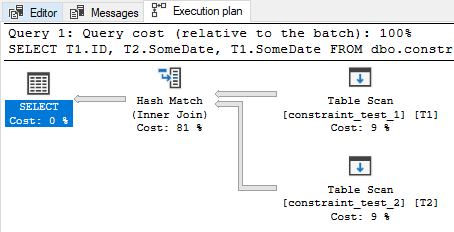Referencing this blog post by Erik Darling on the website of my favorite SQL Server guru - Brent Ozar:
When you select from that table alone, it shows "CouldNotGenerateValidParallelPlan".
But, when you join that table to another that does not have a check constraint/computed column calling a Scalar UDF, the query goes parallel with "Good Enough Plan Found"
USE tempdb;
SET NOCOUNT ON;
SELECT TOP 10000
ROW_NUMBER() OVER ( ORDER BY ( SELECT NULL )) AS ID, DATEADD(MINUTE, m.message_id, SYSDATETIME()) AS SomeDate
INTO dbo.constraint_test_1
FROM sys.messages AS m, sys.messages AS m2;
GO
SELECT TOP 10000
ROW_NUMBER() OVER ( ORDER BY ( SELECT NULL )) AS ID, DATEADD(MINUTE, m.message_id, SYSDATETIME()) AS SomeDate
INTO dbo.constraint_test_2
FROM sys.messages AS m, sys.messages AS m2;
GO
CREATE FUNCTION dbo.DateCheck ( @d DATETIME2(7))
RETURNS BIT
WITH RETURNS NULL ON NULL INPUT
AS
BEGIN
DECLARE @Out BIT;
SELECT @Out = CASE WHEN @d < DATEADD(DAY, 30, SYSDATETIME()) THEN 1 ELSE 0 END;
RETURN @Out;
END;
GO
ALTER TABLE dbo.constraint_test_1 ADD CONSTRAINT ck_cc_dt CHECK ( dbo.DateCheck(SomeDate) = 1 );
SELECT *
FROM dbo.constraint_test_1
OPTION (QUERYTRACEON 8649, MAXDOP 0, RECOMPILE); -- Does not go parallel
SELECT T1.ID, T2.SomeDate
FROM dbo.constraint_test_1 T1 INNER JOIN
dbo.constraint_test_2 T2 ON T1.ID = T2.ID
OPTION (QUERYTRACEON 8649, MAXDOP 0, RECOMPILE); -- Goes parallel


